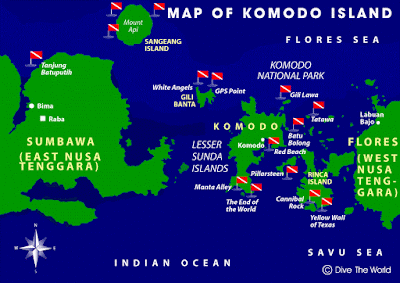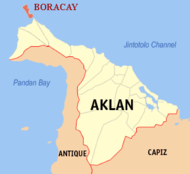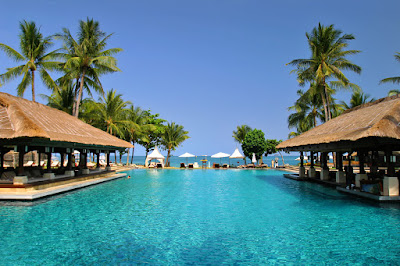Komodo is one of the 17,508 islands that compose the Republic of Indonesia. The island is particularly notable as the habitat of the Komodo dragon, the largest lizard on Earth, which is named after the island. Komodo Island has a surface area of 390 square kilometres and a human population of over two thousand. The people of the island are descendants of former convicts who were exiled to the island and who have mixed with Bugis from Sulawesi. The people are primarily adherents of Islam but there are also Christian and Hindu congregations.
Komodo is part of the Lesser Sunda chain of islands and forms part of the Komodo National Park. In addition, the island is a popular destination for diving. Administratively, it is part of the East Nusa Tenggara province.
Description
Komodo is part of the Lesser Sunda chain of islands and forms part of the Komodo National Park. It lies between the substantially larger neighboring islands Sumbawa to the west and Flores to the east. The island's surface area covers 390 square kilometres.
History
The earliest stories of a dragon existing in the region circulated widely and attracted considerable attention. But no one visited the island to check the story until official interest was sparked in the early 1910s by stories from Dutch sailors based in Flores in East Nusa Tenggara about a mysterious creature. The creature was allegedly a dragon which inhabited a small island in the Lesser Sunda Islands (the main island of which is Flores).
The Dutch sailors reported that the creature measured up to seven metres (twenty-three feet) in length with a large body and mouth which constantly spat fire. Hearing the reports, Lieutenant Steyn van Hensbroek, an official of the Dutch Colonial Administration in Flores, planned a trip to Komodo Island. He armed himself, and accompanied by a team of soldiers he landed on the island. After a few days, Hensbroek managed to kill one of the lizards.
Van Hensbroek took the dragon to headquarters where measurements were taken. It was approximately 2.1 metres (6.9 feet) long, with a shape very similar to that of a lizard. More samples were then photographed by Peter A. Ouwens, the Director of the Zoological Museum and Botanical Gardens in Bogor, Java. The records that Ouwens made are the first reliable documentation of details about what is now called the Komodo dragon (or Komodo monitor).
Ouwens was keen to obtain additional samples. He recruited hunters who killed two dragons measuring 3.1 metres and 3.35 metres as well as capturing two pups, each measuring less than one metre. Ouwens carried out studies on the samples and concluded that the Komodo dragon was not a flame-thrower but was a type of monitor lizard. Research results were published in 1912. Ouwens named the giant lizard Varanus komodoensis. Realizing the significance of the dragons on Komodo Island as an endangered species, the Dutch government issued a regulation on the protection of the lizards on Komodo Island in 1915.
The Komodo dragon became something of a living legend. In the decades since the Komodo was discovered, various scientific expeditions from a range of countries have carried out field research on the dragons on Komodo Island.
Pulau Komodo adalah sebuah pulau yang terletak di Kepulauan Nusa Tenggara. Pulau Komodo dikenal sebagai habitat asli hewan komodo. Pulau ini juga merupakan kawasan Taman Nasional Komodo yang dikelola oleh Pemerintah Pusat. Pulau Komodo berada di sebelah timur Pulau Sumbawa, yang dipisahkan oleh Selat Sape.
Secara administratif, pulau ini termasuk wilayah Kecamatan Komodo, Kabupaten Manggarai Barat, Provinsi Nusa Tenggara Timur, Indonesia. Pulau Komodo merupakan ujung paling barat Provinsi Nusa Tenggara Timur, berbatasan dengan Provinsi Nusa Tenggara Barat.
Di Pulau Komodo, hewan komodo hidup dan berkembang biak dengan baik. Hingga Agustus 2009, di pulau ini terdapat sekitar 1300 ekor komodo. Ditambah dengan pulau lain, seperti Pulau Rinca dan dan Gili Motang, jumlah mereka keseluruhan mencapai sekitar 2500 ekor. Ada pula sekitar 100 ekor komodo di Cagar Alam Wae Wuul di daratan Pulau Flores tapi tidak termasuk wilayah Taman Nasional Komodo.
Selain komodo, pulau ini juga menyimpan eksotisme flora yang beragam kayu sepang yang oleh warga sekitar digunakan sebagi obat dan bahan pewarna pakaian, pohon nitak ini atau sterculia oblongata di yakini berguna sebagai obat dan bijinya gurih dan enak seperti kacang polong.
Pulau Komodo juga diterima sebagai Situs Warisan Dunia UNESCO, karena dalam wilayah Taman Nasional Komodo, bersama dengan Pulau Rinca, Pulau Padar dan Gili Motang
Sejarah
Pada tahun 1910 orang Belanda menamai pulau di sisi selatan Provinsi Nusa Tenggara Timur ini dengan julukan Pulau Komodo. Cerita ini berawal dari Letnan Steyn van Hens Broek yang mencoba membuktikan laporan pasukan Belanda tentang adanya hewan besar menyerupai naga di pulau tersebut. Steyn lantas membunuh seekor komodo tersebut dan membawa dokumentasinya ke Museum and Botanical Garden di Bogor untuk diteliti.
Tahun 2009, Taman Nasional Komodo dinobatkan menjadi finalis "New Seven Wonders of Nature" yang baru diumumkan pada tahun 2010 melalui voting secara online di www.N7W.com.Pada tanggal 11 November 2011, New 7 Wonders telah mengumumkan pemenang sementara, dan Taman Nasional Komodo masuk kedalam jajaran pemenang tersebut bersama dengan, Hutan Amazon, Teluk Halong, Air Terjun Iguazu, Pulau Jeju, Sungai Bawah Tanah Puerto Princesa, dan Table Mountain. Taman Nasional Komodo mendapatkan suara terbanyak.

















































